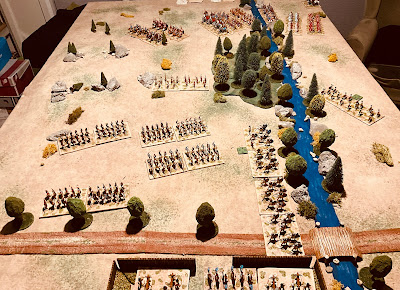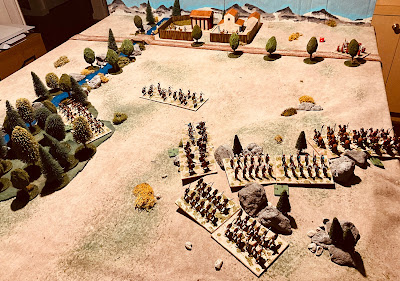After completing a remote World War I Palestine game, I found myself in a rather lazy mood. So instead of tidying up the tabletop, I decided to have a quick Punic War game using my plastic, mainly HAT, armies. After playing a couple of enjoyable solo games during the week I decided a short campaign consisting of 4-6 games ending in a decisive set piece battle would be fun. The question was - how should I approach this?
 |
| A Punic War themed game about to start. |
The idea of leveraging game approaches used in family games has always remained with me after reading a post on Wargaming Miscellany back in 2019. In the post Bob Cordery proposed the idea of drawing inspiration from children's games for campaigns (link here). Previously, I have adapted the Snakes and Ladders game for a Jacobite 1745 campaign (see here). However, this time, I wanted to take a slightly different approach – something that would allow me to create a map board with narrative prompts on the map, thereby eliminating the need to use chance cards or dice rolls on chance tables.
I decided to look at the “race to the finish” style game format, which features a game board designed as a track with a starting point and a finish line. Traditionally, players would roll the dice, moving their tokens forward based on the result. However, in this case, there would only be one player – me.
 |
| An example of a “race to the finish” game |
The remainder of this post is about how the mini campaign is set up.
- Background and the reasons for conflict
- Creating a map board
- Writhe rules
There will be following posts on how the campaign progresses.
1) Background and Reasons for a Conflict
The first step was to create a campaign background along with reasons for the conflict. To help I used the ChatGPT AI tool and asked the question “Create a background and reasons for a Roman army to be facing a Carthaginian army.”
To this question ChatGPT provided 5 reasons and I opted for “Alliance Disputes” where the complex network of alliances and client states in the Mediterranean often sparked conflicts between Rome and Carthage. The campaign would have a Roman client state being attacked by Carthaginian forces, prompting Rome to intervene militarily to protect its interests.
So with my reason decided, the next step was to decide upon a historical state or create a hypothetical client state. I opted for the latter and went to ChatGPT again and asked the question “Create a description of a hypothetical country on the Mediterranean coast in 200 BCE. Name at least 15 cities in this country.”
I am not sure why I asked for 15 cities, but it did provide a variety of descriptions for 15 cities from which to choose from when creating a map. All very helpful and time saving for me.
2) Creating the Campaign Map
To begin with I roughly sketched out how I saw the map, then I played a test game using opposing dice rolls to replace the tabletop battles.
 |
| The sketched out map being used for a play test. The paper is art paper for water colours and is very think, needing to be weighted down. |
Following a reasonably smooth play test, it was time to try something new and draw the map using water colour pencils. Water colour pencils are pencils with a pigment core that dissolves in water. They can be used like coloured pencils then activated by a wet brush. With the brush you can achieve washes, gradients, and textures. I also used a black pen for the text and outlining where it was required to sharpen the drawings (the buildings for example).
 |
| The map drawn using water colour pencils. |
 |
| A closer look at the map. The narrative elements are written into the squares and beside the towns and cities. |
Around the side of the map are a couple of tables which are used in the campaign to track the attackers and defender’s battle readiness. More on this in the rules and how these tables influence the decisive last battle fought on the tabletop.
 |
| Attacker’s battle readiness table. |
 |
| Defender’s battle readiness table. |
3) The Rules
Objective:
The goal of the game is to move the attacker's token from its starting position to the capital city of Aurelia and engage in a final tabletop battle.
Setup:
- Place the attacker's token on the start square.
- Set up other tokens on the battle readiness tables for both the attacker and defender.
Gameplay:
- The attacking player starts and rolls a dice (D6) on their turn. They move their token forward the number of squares indicated by the dice roll.
- After each roll, the defender moves their token up one square on their battle readiness table, which can impact the decisive tabletop battle once the city of Aurelia is reached.
- Certain squares on the game board offer advantages if the player finishes on them, allowing them to advance their token. Other squares are disadvantages, forcing the player to retreat their token.
- When the attacker passes through a town or city square, a tabletop battle takes place using a scenario from the book One-Hour Wargames.
- The tabletop battles are played out, and if the attacker wins, the defender moves their token down 3 squares on their battle readiness table and moves the attacker's token up 1 square on their battle readiness table.
- The attacker then rolls the dice and moves again, continuing the cycle.
- Once the attacking token reaches the capital city square, a final decisive tabletop battle occurs, where both players can utilise the advantages from their battle readiness tables.
Victory:
The game ends when the attacker engages in the final decisive tabletop battle in the capital city of Aurelia. The outcome of this battle will determine the winner of the game.
Note:
- The specific rules and mechanics of the tabletop battles and battle readiness tables are separate.
- The last decisive tabletop battle will be a set piece scenario.
 |
| News of a Carthaginian landing has reached the local commander. |
The next few posts will continue with the setup and playing of this mini campaign.


































































